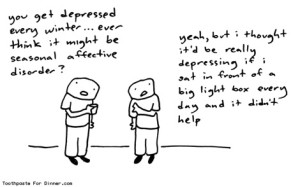As someone who experiences a rather terrible drop in happiness and contentment in the face of a long, sun-less winter, I’m relishing the recent sun. I’m noticeably less irritated by people, I have more motivation, I actually want to be outside… I feel like a new person. Why is the presence of sun making such a difference?
Seattle is a great place to experience first-hand the effects a lack of sun can have on mood. Some may say that it’s just a matter of resolution; if you can just STAY POSITIVE, you can get out of it! Obviously. Because that’s how it works with all other mental disorders (that’s sarcasm). Up to a certain point, that might be true. Our perception of how we should be thinking plays an enormous role in our emotional outlook, but in the case of most disorders, it’s a chemical and physical change that’s messing with cognition. In the case of seasonal affective disorder, or SAD (fitting name), it’s because our brains aren’t receiving enough signal from light and it ends up disrupting sleep/wake cycles and all other kinds of internal processes that maintain a normal, healthy outlook. Thus, the sad happens.
SAD occurs in about 5-10% of the population (moreso in people living in areas away from the equator) , and many people experience the winter blues despite not quite making diagnostic criteria (1). The current working hypotheses focus on the disruption of light signals to central parts in our brain involved with circadian rhythms, the cycles of hormones that dictate when when fall asleep, wake up, eat, and do all sorts of other things. When we wake up in the morning, sun light stimulates our optic nerve in the eye and sends a signal to the suprachiasmatic nucleus (supra=above, chiasm= the crossing over of your two optic nerves from each of your eyes; abbreviated as SCN), the little part of the brain that does most of the controlling for circadian rhythms. The SCN then tells the hypothalamus and pineal gland to send out the appropriate signals to wake you up and is responsible for many downstream signal molecules like melatonin, which helps regulate the sleep cycle by promoting sleep (2). Melatonin is a major player in SAD; because sun is a melatonin suppressant and melatonin is a sleep promoter, when we don’t get enough sun, we get too much melatonin and therefore screw up sleep schedules and a whole host of other problems connected to it (2).
SAD is also said to affect dopamine signalling, but the mechanism is unclear; so far, we have some genetic correlations, but no clear answer (3). SAD also affects serotonin, which is also involved with sleep/wake cycles, and classes of antidepressants like selective serotonin reuptake inhibitors (SSRIs) can help with SAD by helping to bring back normal regulation (4). Vitamin D (the “sunshine vitamin”) is often linked to SAD, but it’s unclear if depression causes low D, or if low D causes depression (5). Regardless, raising vitamin D levels with helping to regulate other hormones, as Vitamin D is a precourser to many of the steroid hormones that affect mood. Treatment is generally centered around balancing your brain: give your eyes more light at the right times, get your serotonin and other neuromodulators back on track, and control your SADness.
What does all this biology have to do with our moods? Our moods are dependent on not only our environments and learning, but also on the physical changes brought about through regulatory mechanisms like signals from light hitting all the right spots. If some molecule isn’t in the right amounts at the right times, our whole day can get muddled and our cognition slows or gets depressive. We don’t have enough research to tell you WHY exactly our cognition changes (but we’re getting a little closer; we’ve done a lot of cool research into modeling neurons; I’ve written about this before), but we can look at the correlates of specific neurotransmitters and types of cognition, and get a rough estimate of what chemicals are involved with what mood. Sleep/wake cycles use a TON of different molecules that have intersecting pathways and many different uses, and it’s a very complicated process. The end result is that when we disrupt sleep cycles and mess with nature’s effects on our bodies, we get a tad unhappy. Therefore, we must soak up the spring Seattle sun and banish the blues as best we can.
References
1. Byrne, B., & Brainard, G.C. (2008) Seasonal affective disorder and light therapy. Sleep Med Clin. 3(2):307–315.
2. Levitan, R.D. (2007). The chronobiology and neurobiology of winter seasonal affective disorder. Dialogues Clin Neurosci. 9(3):315-24.
3. Kurlansik, S.L., & Ibay, A.D. (2013) Seasonal affective disorder. Am Fam Physician.86(11):1037-41.
4. A. Gupta, P.K. Sharma, V.K. Garg, A.K. Singh, S.C. (2013) Mondal Role of serotonin in seasonal affective disorder. Eur Rev Med Pharmacol Sci, 17:1 (49-55).
5. Bertone-Johnson, E.R. (2009) Vitamin D and the occurrence of depression: causal association or circumstantial evidence?. Nutr Rev. 67(8):481-92.
http://www.ncbi.nlm.nih.gov/pmc/articles/PMC1925042/#!po=7.50000
http://www.europeanreview.org/article/1251
http://www.aafp.org/afp/2006/1101/p1521.html
http://www.aafp.org/afp/2012/1201/p1037.html#afp20121201p1037-b6
http://www.ncbi.nlm.nih.gov/pmc/articles/PMC3202491/
http://www.ncbi.nlm.nih.gov/pubmed/19674344











